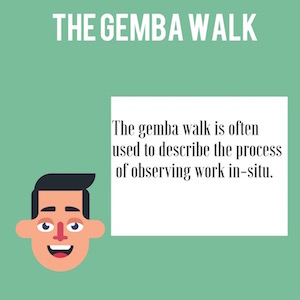 Many personnel within management will go and review what happens in situ in the workplace – they will walk around and take a look to get a feel for the activity and by talking to the workforce attempting to get a rudimentary understanding of what works and what doesn’t. This style of management by “walking around” invariably is hit and miss. This is generally because those undertaking the review are not usually armed with the right questions to ask or often empowered to make change.
Many personnel within management will go and review what happens in situ in the workplace – they will walk around and take a look to get a feel for the activity and by talking to the workforce attempting to get a rudimentary understanding of what works and what doesn’t. This style of management by “walking around” invariably is hit and miss. This is generally because those undertaking the review are not usually armed with the right questions to ask or often empowered to make change.
However with the right structure, a Gemba walk can be a very effective tool in driving process improvements (i.e. faster and more cost-effective) but to be at its most effective, this requires a more structured process
Within Kaizen the term Gemba walk is often used to describe the process of observing work in situ. Moving past the term of Gemba Walk (it’s just a term after all) effective in situ work monitoring usually requires the following steps:
1/ An understanding of the process
2/ Observing the process at an appropriate time
3/ Observing the process in the right place (i.e. where the value is created)
4/ Observe the process take place (together with the operators that execute the process).
5/ Recognise how the process works in its current state
6/ Understand the ideal state
7/ Be able to articulate the gaps between current and ideal state
8/ Be able to articulate the steps required to go from current to an ideal state.
Perhaps the key is knowing what questions to ask. The typical problem with a management walk around is that they don’t usually observe for long enough, don’t know the questions to ask and cannot identify the changes required to the current state. In simple terms, they may know it’s wrong but can’t articulate what changes are needed.
Of course, the first step is that by undertaking a Gemba walk you’ve identified where you need to be, at least partially, to drive your business forward. How frequently all the members of the management team undertake such an exercise varies. Of course Operations executives may do this daily, others may do it less so. Perhaps the key in being effective is ensuring those that can both visualize and empower change are regular participants.
The next stage is where, or what process you should review. Often this is self-explanatory (i.e. it’s obvious where the process isn’t working) but in most flow systems there are specific nodes or steps that can be assessed. These will typically have KPI’s associated with them so you could review the worst performing parts of the process in sequence looking to remove bottlenecks and waste.
Creating a set structure for your Gemba walk with a specific check list where variables, values or notes can be taken can help add some necessary rigor to the process (especially where the team may not have significant lean experience).
We’ve included a sample Gemba checklist at the bottom of this article (we hope you find it useful!).
Once you’ve captured you’re findings you can then evaluate them for signs of the 7 wastes.
Lastly, it’s important to understand that as with all processes don’t expect Gemba Walks to solve everything overnight, think of it as a tool that can members of the senior management evaluate processes, focussing on the heart of the business and the key issues the business faces. Also don’t underestimate the value that Gemba provides in enabling access to management for shop floor workers, used appropriately Gemba can improve communication significantly.
We hoped you liked this article and you found it useful – we’d love your feedback in the comments section below.
Gemba Walk Checklist – key questions to ask on Gemba Walk
1 What Process is being observed (note this may be the whole process or a step in the process)
2 Description of the step being observed
3 What customer value is added during this process
4 What KPI’s are in place to cover this process (are they in tolerance)
5 Has a standard been defined to imply correct operation of the process (and is this measured)
6 Has the process (or process step) been documented so instructions can be followed?
7 Was the documented process followed
8 What actions are being taken
9 Which personnel are involved with this step
10 Who leads the activity
11 Are all personnel suitably trained/skilled
12 What equipment is used for this activity and was it functioning correctly?
13 Does the equipment have the correct capabilities for the step being reviewed
14 Is the layout/work area supportive of the process
15 Is there sufficient equipment to carry out the process
16 What is the targeted process time for this step and was it achieved?
17 What barriers to flow are observed?
18 How much of the process adds value
19 What Queuing time occurs
20 How many items are currently queuing
21 How many finished items from this process are waiting to be transported to the next step.
22 How many items created by the process didn’t meet the standards required
You can download these questions to ask on a Gemba walk as a pdf here